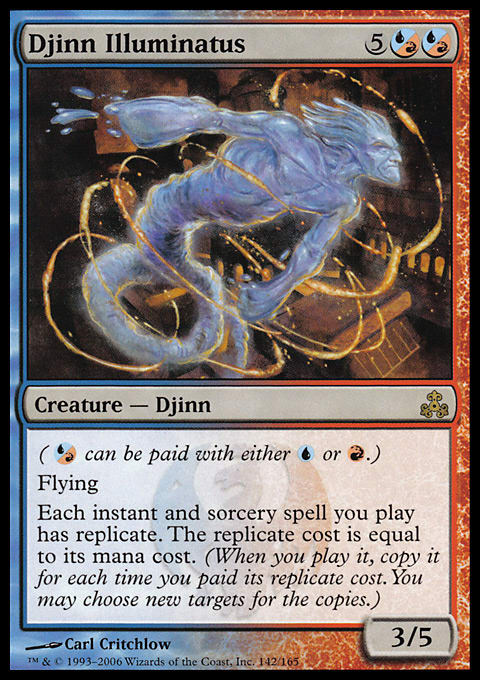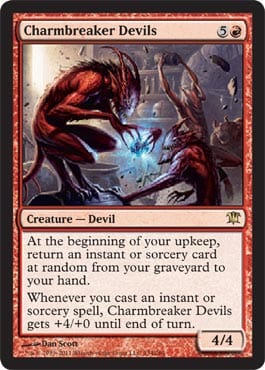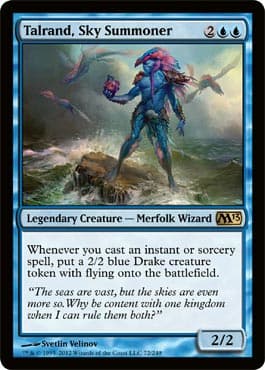I don’t think any guild is a better representation of the average casual player than Izzet. You see them all the time in multiplayer games. I’m not saying the average casual player always plays some kind of U/R deck. In fact, U/R is probably a color combination I rarely see in multiplayer games. Most of the games I’m in involve a lot of creature interaction. While blue and red have plenty of great creatures, they don’t tend to be the first colors you think about when considering creature options.

Famous Izzet Philosopher: Steve Urkel
What I am saying is that the Izzet philosophy is rampant among most casual players. When I picture someone in the Izzet guild, I see someone who makes the explosion without thinking about the fallout until afterward. An Izzet carpenter would use a small explosive to knock down a wall and then wonder if it would have been better to just use a sledge hammer . . . after blowing up the entire house.
So many players follow this same philosophy. They build their decks looking for the cool play, but they don’t think about what will happen after the cool play, when your opponents realize that you are a serious danger to their plans.
I am not Izzet. My philosophy has always been to lay low and build slowly and deliberately. Don’t draw attention to yourself or you’ll be left trying to fight all of your opponents at once. It is better to let them fight each other and then step in at the end and eliminate the single, helpless opponent still left standing.
However, this is Izzet week, and it seems to be a good time to give into the allure of the explosive play. Ever since I opened my third copy of Galvanoth, I’ve known that I wanted to build an Izzet deck that used amazing instants and sorceries with creatures that received benefits because you played the spells. This deck just seemed to fly in the face of my usual deck style. Flashy spells with big, game-changing turns would come out of nowhere against my metagame!

Famous Izzet Philosopher: Tim “the Tool Man” Taylor
I went through and started to look at the various creatures that interacted with sorceries and instants. I stuck a bunch together and started to look for splashy spells to add to the mix. It was at this point I discovered an issue.
Kiln Fiend and Wee Dragonauts want you to cast numerous spells in a single turn. They are all-stars when you can play several spells in one turn. Djinn Illuminatus and replicate spells do just that. These are cards that want you to play multiple 1- and 2-mana instants every turn.
Galvanoth, Echo Mage, and Hypersonic Dragon are all looking for big sorceries to generate the most benefit, not the oft-repeatable cheap instants that Kiln Fiend and his ilk want. So, what to do?
I started by trying to put it all together, but that just left me with what felt like two different decks that didn’t do anything well. I knew fairly early on that I was going to have to pick one way or the other. While going with the expensive creatures and expensive sorceries appealed to the Izzet’s go-big philosophy I talked about, the mana curve was such that I couldn’t see how I was going to be alive long enough to make these flashy plays. Instead, I opted to go with the lower-mana-cost option. It wouldn’t be as flashy, but it would probably be more effective.
. . . Look, I told you early on that I’m not Izzet!
I went digging for various options to work in the deck, and I ended up with this:
"Is It Going to Work? 1.0"
- Creatures (14)
- 1 Gelectrode
- 1 Surrakar Spellblade
- 2 Charmbreaker Devils
- 3 Djinn Illuminatus
- 3 Kiln Fiend
- 3 Wee Dragonauts
- 1 Talrand, Sky Summoner
- Spells (22)
- 1 Brainstorm
- 1 Fury Charm
- 1 Lightning Bolt
- 1 Ovinize
- 1 Thunderous Wrath
- 2 Shadow Rift
- 1 Artful Dodge
- 1 Browbeat
- 1 Cloak of Feathers
- 1 Distortion Strike
- 1 Haze of Rage
- 1 Portent
- 1 Windfall
- 1 Leering Emblem
- 1 Thran Foundry
- 2 Feldon's Cane
- 2 Isochron Scepter
- 2 Sensei's Divining Top
- Lands (24)
- 8 Mountain
- 9 Island
- 1 Smoldering Spires
- 1 Steam Vents
- 2 Volcanic Island
- 3 Sulfur Falls
Just a couple of things you should know before we go any further: I wanted four Talrand, Sky Summoner in this deck, but I only had one at the time. I knew I wanted to make that change before ever playing a game with the deck. The reason I have so many one-ofs among the instants is that I wanted the variety, and I wanted to see if any of them were even bigger all-stars than I thought. This is called foreshadowing, people. Pay attention!
This deck is not all that innovative. Get out a couple of creatures, preferably with a Djinn Illuminatus, then play an instant or two or replicate one of the instants a few times, and smash with your suddenly big creatures.
“What is he talking about? Hidden Alliances?”
This is a multiplayer variant. Before you start the game, select different basic lands and spells of the same color as the different lands in an amount equal to the number of players. Pass them out face-down, then have the players who received lands turn them face-up. They are allied with the player who has the spell that matches the land. This means that the players with the land don’t know who their ally is. The players without lands know only who their ally is. Play as a usual Chaos game with the winner being the final team or player still in the game. If there are an odd number of players, add an artifact to the mix. That player is on his own and wins when everyone else is dead.
The first several turns, especially for the hidden-alliance players, involved ramping up. I managed to cast an early Divining Top and Isochron Scepter with Cloak of Feathers into play. The Cloak of Feathers was great, as it allowed me to give a random creatures flying until the end of the turn, but more importantly, it let me draw an extra card once per round. The downside is that it was completely illegal—you can’t imprint a sorcery on the Scepter! Shame none of us noticed that until I started writing this article! The extra cards set me up with Kiln Fiend, Charmbreaker Devils, and a Djinn Illuminatus.
I sat for a few more turns as the other hidden-alliance players were swinging at each other, and I didn’t want to get hit with any crossfire. My ally Spencer was being pummeled by Jesse’s planeswalkers, so I worked out the numbers and hit Jesse hard on my next turn. With only one blocker out, I swung with both the Kiln Fiend and the Charmbreaker Devils, then played Lightning Bolt and replicated it five times. The 18 damage was mostly dealt to Jesse, but I did spread it around to hit some of the other dangerous targets on the board. At this point, the only people who didn’t get hit were Spencer and George, and that was only because George still didn’t know if I was his ally or not, and I didn’t want him to attack me. My attack on Jesse should have put him out of the game, but I had not considered the lifelink on Wurmcoil Engine, and he ended up at 3 life after the dust had settled.
The turns went around the board, and I took some damage, but nothing too serious. I think Josh could have crippled me with his Vampire deck, but he could see that my combo was pretty precarious, so he passed. Jesse was happy to bulk up his defenses and pump his life total up, so he also did nothing. Spencer, my ally, was struggling to keep even one creature on the board to go with his Jitte and other Equipment in play. George was wary of Jesse and still unsure who his ally was, so he did not swing my way either. Bryan poked me with a couple of creatures, but I wasn’t going to risk my creatures to stop 4 or 5 points of damage, so I let it through.
On my next turn, the Lightning Bolt came back to my hand due to the Charmbreaker Devils ability. Having only one instant or sorcery in your graveyard is tech with that creature! I wound up and hit again, taking Josh out, but not before losing the Djinn and the Scepter. Spencer was also knocked out at this point. The alliances were discovered, and George and Bryan were the only allies left. Jesse and I agreed to a hasty truce, but it did me little good against George’s Phyrexian Dreadnought. Jesse fought on for several more turns, but two-on-one became too much for him to handle.
With a game under my belt, I spotted some changes that I wanted to make right away. The current version of the deck is as follows:
"Is It Going to Work Now? 2.0"
- Creatures (16)
- 1 Gelectrode
- 1 Surrakar Spellblade
- 3 Charmbreaker Devils
- 3 Wee Dragonauts
- 4 Djinn Illuminatus
- 4 Talrand, Sky Summoner
- Spells (20)
- 1 Brainstorm
- 1 Fury Charm
- 1 Leap
- 1 Lightning Bolt
- 1 Ovinize
- 2 Shadow Rift
- 1 Artful Dodge
- 1 Browbeat
- 1 Distortion Strike
- 1 Haze of Rage
- 1 Portent
- 1 Windfall
- 1 Leering Emblem
- 2 Isochron Scepter
- 2 Sensei's Divining Top
- 2 Thran Foundry
- Lands (24)
- 8 Mountain
- 9 Island
- 1 Smoldering Spires
- 1 Steam Vents
- 2 Volcanic Island
- 3 Sulfur Falls
My respect for 1-mana instant cantrips went through the roof after this game. Constantly replacing a lost card is great for this deck. Replicating a cantrip is a joy. While I have not added more instant cantrips, that will be a change in the future.
I dumped the Kiln Fiends in favor of more Talrands and another Djinn. While I’m generally reluctant to put four copies of a 7-mana creature in a deck, his ability to give replicate to instants and sorceries is something that I always want to have available. The Kiln Fiends sat back and didn’t attack several times because the toughness wasn’t enough or because I knew I would want a blocker. Talrand’s Drakes give me evasion and allow me to keep some of them back as blockers when needed. The flexibility Talrand, Sky Summoner offers pushed the Kiln Fiends out of the deck.
I ran Feldon's Cane because I expected that my library would run dry. I pictured drawing several cards per turn and coming close to decking myself, and I wanted a safeguard in case that happened. Instead, I found that I wanted to empty my opponents’ graveyards more often, so the extra Thran Foundry came in. I suspect these may come out entirely in favor of more creatures or instants, but for now, my insurance stays in.
While I took what I thought would be the safer path, in true Izzet fashion, the resulting deck proved far more explosive than I expected. I will need to play it more carefully to earn some wins, but the explosions were over the top! I can understand the allure of Izzet philosophy!
Bruce Richard
























